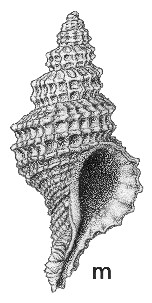
Revised descriptions of New Zealand Cenozoic Mollusca from Beu and Maxwell (1990)

 | Revised descriptions of New Zealand Cenozoic Mollusca from Beu and Maxwell (1990) | 
|
  (Pl. 48m): Castlecliff, Wanganui, Castlecliffian (GNS, early collection) |
Beu & Maxwell (1990): Chapter 16; p. 359; pl. 48 m.
Synonymy: Trophon stangeri Hutton 1893, p. 38, not of Gray, 1843; Trophon (Trophonopsis) bonneti Cossmann 1903, p. 200; Zeatrophon bonneti; Xymene bonneti bonneti, Beu & Maxwell 1990, p. 359, pl. 48 m
Classification: Muricidae: Ocenebrinae?
Description: Small for family (18-27 mm high), narrowly fusiform, with moderately tall spire (equal to aperture and canal), and moderately long, open anterior canal; very crisply sculptured. Aperture oval, with weakly reflected lips, indented inside outer lip by spiral cords on exterior. Sculpture of prominent, narrow spiral cords of rounded section, 2 on spire whorls and about 12 on last whorl, the uppermost 3 more widely spaced than remainder; all crossed by many high, thin, regularly spaced, weakly frilled axial lamellae, forming weak nodules or spines at intersections on some specimens; the uppermost spiral cord is the most prominent sculpture, and forms a sharply protruding shoulder angle and a narrow, flat, gently sloping sutural ramp. Protoconch conical, of 3 whorls, smooth except for prominent median carina on last whorl.
Comparison: Ponder (1972) included all New Zealand small "trophonines" (subfamily classification uncertain as yet) in Xymene, but Beu (2009) separated the genera Zeatrophon, Axymene and Xymenella again from Xymene, as a beginning to determining the real genera among these groups. Ponder (1972) also regarded the Altonian-Nukumaruan "Xymene" bonneti lassus as a subspecies intergrading with X. bonneti bonneti in Nukumaruan rocks and differing from X. bonneti bonneti in its lower spire, its weaker shoulder cord, and its more prominent secondary axial and spiral sculpture. However, re-examination of these shells by Beu (2009) indicated that they intergrade, and are all better considered part of the single anagenetically evolving species Zeatrophon bonneti. The living Z. mortenseni caudatinus Finlay is also similar, differing from Z. bonneti in its weaker shoulder cord, its more complex, frilled axial lamellae, and in consistently having a secondary spiral cord in each spiral interspace. Readers are referred to Ponder's (1972a) revision of Xymene and its relatives for details of other fossil and living species, remembering that several taxa are confused in this revision (see also Xymene expansus, Pl. 48e; Xymenella n. sp. aff. lepida, Pl. 20n). Zeatrophon bonneti washes ashore on Wellington west coast beaches (particularly at Waikanae River mouth) but the specimens are opaque and stained fawn or grey, and are undoubtedly among the many Castlecliffian fossils to be found there.
Distribution: Altonian?; Waiauan-Castlecliffian. "Wanganui, New Zealand", Castlecliffian (type); moderately common in shelf siltstone facies (Kai-Iwi siltstone beds, Tainui Shellbed) at Wanganui (Castlecliffian), recorded uncommonly from a number of other localities in siltstone of Miocene and Pliocene age throughout New Zealand.
Cite this publication as: "A.G. Beu and J.I. Raine (2009). Revised
descriptions of New Zealand Cenozoic Mollusca from Beu and Maxwell (1990). GNS
Science miscellaneous series no. 27."
© GNS Science, 2009
ISBN
978-0-478-19705-1
ISSN 1177-2441
(Included with a PDF facsimile file
copy of New Zealand Geological Survey Paleontological Bulletin 58 in CD version
from: Publications Officer, GNS Science, P.O. Box 30368 Lower Hutt, New
Zealand)